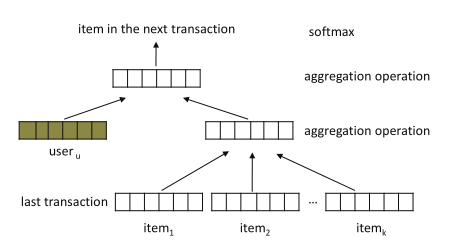HRM¶
Introduction¶
Title: HRM: Learning Hierarchical Representation Model for Next Basket Recommendation.
Authors: Pengfei Wang
Abstract: Next basket recommendation is a crucial task in market basket analysis. Given a user’s purchase history, usually a sequence of transaction data, one attempts to build a recommender that can predict the next few items that the user most probably would like. Ideally, a good recommender should be able to explore the sequential behavior (i.e., buying one item leads to buying another next), as well as account for users’ general taste (i.e., what items a user is typically interested in) for recommendation. Moreover, these two factors may interact with each other to influence users’ next purchase. To tackle the above problems, in this paper, we introduce a novel recommendation approach, namely hierarchical representation model (HRM). HRM can well capture both sequential behavior and users’ general taste by involving transaction and user representations in prediction. Meanwhile, the flexibility of applying different aggregation operations, especially nonlinear operations, on representations allows us to model complicated interactions among different factors. Theoretically, we show that our model subsumes several existing methods when choosing proper aggregation operations. Empirically, we demonstrate that our model can consistently outperform the state-of-the-art baselines under different evaluation metrics on real-world transaction data.

Running with RecBole¶
Model Hyper-Parameters:
embedding_size (int): The embedding size of users and items. Defaults to64.high_order (int): The last N items . Defaults to2.pooling_type_layer_1 (str): The type of pooling in the first floor include average pooling and max pooling . Defaults tomax.pooling_type_layer_2 (str): The type of pooling in the second floor include average pooling and max pooling . Defaults tomax.dropout_prob (float): The dropout rate. Defaults to0.2.loss_type (str): The type of loss function. If it is set to'CE', the training task is regarded as a multi-classification task and the target item is the ground truth. In this way, negative sampling is not needed. If it is set to'BPR', the training task will be optimized in the pair-wise way, which maximizes the difference between the positive item and the negative one. In this way, negative sampling is necessary, such as setting--train_neg_sample_args="{'distribution': 'uniform', 'sample_num': 1}". Defaults to'CE'. Range in['BPR', 'CE'].
A Running Example:
Write the following code to a python file, such as run.py
from recbole.quick_start import run_recbole
parameter_dict = {
'train_neg_sample_args': None,
}
run_recbole(model='HRM', dataset='ml-100k', config_dict=parameter_dict)
And then:
python run.py
Notes:
By setting
reproducibility=False, the training speed of HRM can be greatly accelerated.
Tuning Hyper Parameters¶
If you want to use HyperTuning to tune hyper parameters of this model, you can copy the following settings and name it as hyper.test.
learning_rate choice [0.001]
embedding_size choice [64]
high_order choice [1,2,4]
dropout_prob choice [0.2]
pooling_type_layer_1 choice ["max","average"]
pooling_type_layer_2 choice ["max","average"]
Note that we just provide these hyper parameter ranges for reference only, and we can not guarantee that they are the optimal range of this model.
Then, with the source code of RecBole (you can download it from GitHub), you can run the run_hyper.py to tuning:
python run_hyper.py --model=[model_name] --dataset=[dataset_name] --config_files=[config_files_path] --params_file=hyper.test
For more details about Parameter Tuning, refer to Parameter Tuning.
If you want to change parameters, dataset or evaluation settings, take a look at